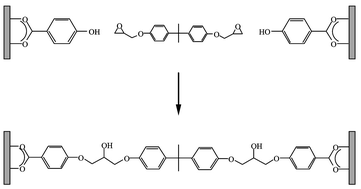In order to produce molecular coupling layers, epoxy resins cross-linked with self-assembled monolayers (SAMs) grown on the native oxide of aluminium have been investigated. Initially, SAMs were formed by the attachment of carboxylic acids, RCO2H [R = C17H35, CH3, C6H4-3-Br, C6H4-4-OH, and C(NH2)(CH2)4NH2], to the native oxides of aluminium thin films on silicon substrates. In order to investigate the cross-linking reaction between carboxylate monolayers and an epoxide, grown monolayers of p-hydroxybenzoic acid and lysine were reacted with a mono-epoxy resin, 1,2-epoxy-3-phenoxypropane. The SAM systems have been characterized by X-ray photoelectron spectroscopy, electron dispersive X-ray analysis, and contact angle measurements. In addition to these surface materials, aluminium oxide surfaces supporting either lysine or p-hydroxybenzoic acid monolayers were reacted in pairs with a di-epoxide (the diglycidyl ether of bisphenol-A) to form an adhesive layer between the two surfaces. Finally, this epoxide–SAM interaction is shown to form a “molecular glue”-type interface, which has been characterized by scanning electron microscopy.


 Please wait while we load your content...
Please wait while we load your content...